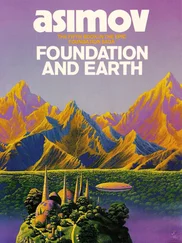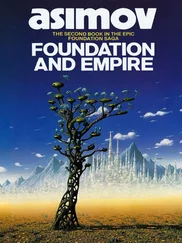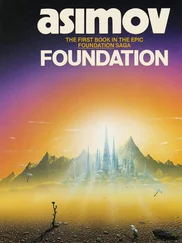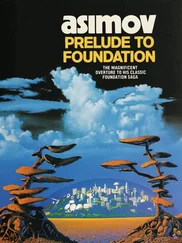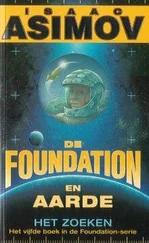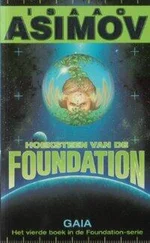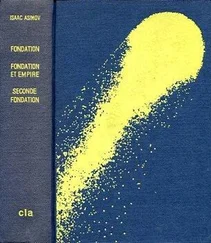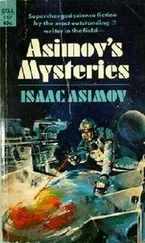He said, “Well done! However, you will consult me in the future before making decisions of this nature.”
The flickering signal caught his attention.
“That’s the engine room,” said Channis, casually. “They warmed up on five minutes’ notice and I asked them to let me know if there was any trouble. Want to hold the fort?”
Pritcher nodded mutely, and cogitated in the sudden loneliness on the evils of approaching fifty. The visiplate was sparsely starred. The main body of the Galaxy misted one end. What if he were free of the Mule’s influence—
But he recoiled in horror at the thought.
Chief Engineer Huxlani looked sharply at the young, ununiformed man who carried himself with the assurance of a Fleet officer and seemed to be in a position of authority. Huxlani, as a regular Fleet man from the days his chin had dripped milk, generally confused authority with specific insignia.
But the Mule had appointed this man, and the Mule was, of course, the last word. The only word, for that matter. Not even subconsciously did he question that. Emotional control went deep.
He handed Channis the little oval object without a word.
Channis hefted it, and smiled engagingly.
“You’re a Foundation man, aren’t you, chief?”
“Yes, sir. I served in the Foundation Fleet eighteen years before the First Citizen took over.”
“Foundation training in engineering?”
“Qualified Technician, First Class—Central School on Anacreon.”
“Good enough. And you found this on the communication circuit, where I asked you to look?”
“Yes, sir.”
“Does it belong there?”
“No, sir.”
“Then what is it?”
“A hyper-relay, sir.”
“That’s not enough. I’m not a Foundation man. What is it?”
“It’s a device to allow the ship to be traced through hyperspace.”
“In other words we can be followed anywhere.”
“Yes, sir.”
“All right. This version is a recent improvement, isn’t it? It was developed by one of the Research Institutes set up by the First Citizen, wasn’t it?”
“I believe so, sir.”
“And its workings are a government secret. Right?”
“I believe so, sir.”
“Yet here it is. Intriguing.”
Channis tossed the hyper-relay methodically from hand to hand for a few seconds. Then, sharply, he held it out, “Take it, then, and put it back exactly where you found it and exactly how you found it. Understand? And then forget this incident. Entirely!”
The chief choked down his near-automatic salute, turned sharply, and left.
The ship bounded through the Galaxy, its path a wide-spaced dotted line through the stars. The dots referred to were the scant stretches of ten to sixty light-seconds spent in normal space and between them stretched gaps of many parsecs that represented the Jumps through hyperspace.
Bail Channis sat at the control panel of the Lens and felt again the involuntary surge of near-worship at the contemplation of it. He was not a Foundation man and the interplay of forces at the twist of a knob or the breaking of a contact was not second nature to him.
Not that the Lens ought quite to bore even a Foundation man. Within its unbelievably compact body were enough electronic circuits to pinpoint accurately a hundred million separate stars in exact relationship to each other. And as if that were not a feat in itself, it was further capable of translating any given portion of the Galactic Field along any of the three spatial axes or of rotating any portion of the Field about a center.
It was because of that, that the Lens had performed a near-revolution in interstellar travel. In the younger days of interstellar travel, the calculation of each Jump through hyperspace meant any amount of work from a day to a week—and the larger portion of such work was the more or less precise calculation of “Ship’s Position” on the Galactic scale of reference. Essentially that meant the accurate observation of at least three widely-spaced stars, the positions of which, with reference to the arbitrary Galactic triple-zero, were known.
And it is the word “known,” that is the catch. To any who know the star field well from one certain reference point, stars are as individual as people. Jump ten parsecs, however, and not even your own sun is recognizable. It may not even be visible.
The answer was, of course, spectroscopic analysis. For centuries, the main object of interstellar engineering was the analysis of the “light signature” of more and more stars in greater and greater detail. With this, and the growing precision of the Jump itself, standard routes of travel through the Galaxy were adopted and interstellar travel became less of an art and more of a science.
And yet, even under the Foundation with improved computers and a new method of mechanically scanning the star field for a known “light signature,” it sometimes took days to locate three stars and then calculate position in regions not previously familiar to the pilot.
It was the Lens that changed all that. For one thing it required only a single known star. For another, even a space tyro such as Channis could operate it.
The nearest sizable star at the moment was Vincetori, according to Jump calculations, and on the visiplate now, a bright star was centered. Channis hoped that it was Vincetori.
The field screen of the Lens was thrown directly next to that of the visiplate and with careful fingers, Channis punched out the co-ordinates of Vincetori. He closed a relay, and the star field sprang to bright view. In it, too, a bright star was centered, but otherwise there seemed no relationship. He adjusted the Lens along the Z-Axis and expanded the Field to where the photometer showed both centered stars to be of equal brightness.
Channis looked for a second star, sizably bright, on the visiplate and found one on the field screen to correspond. Slowly, he rotated the screen to similar angular deflection. He twisted his mouth and rejected the result with a grimace. Again he rotated and another bright star was brought into position, and a third. And then he grinned. That did it. Perhaps a specialist with trained relationship perception might have clicked first try, but he’d settle for three.
That was the adjustment. In the final step, the two fields overlapped and merged into a sea of not-quite-rightness. Most of the stars were close doubles. But the fine adjustment did not take long. The double stars melted together, one field remained, and the “Ship’s Position” could now be read directly off the dials. The entire procedure had taken less than half an hour.
Channis found Han Pritcher in his private quarters. The general was quite apparently preparing for bed. He looked up.
“News?”
“Not particularly. We’ll be at Tazenda in another hop.”
“I know.”
“I don’t want to bother you if you’re turning in, but have you looked through the film we picked up in Cil?”
Han Pritcher cast a disparaging look at the article in question, where it lay in its black case upon his low bookshelf, “Yes.”
“And what do you think?”
“I think that if there was ever any science to History, it has been quite lost in this region of the Galaxy.”
Channis grinned broadly, “I know what you mean. Rather barren, isn’t it?”
“Not if you enjoy personal chronicles of rulers. Probably unreliable, I should say, in both directions. Where history concerns mainly personalities, the drawings become either black or white according to the interests of the writer. I find it all remarkably useless.”
“But there is talk about Tazenda. That’s the point I tried to make when I gave you the film. It’s the only one I could find that even mentioned them.”
Читать дальше
Конец ознакомительного отрывка
Купить книгу

